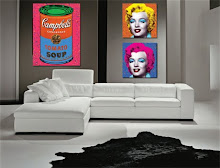


Eugene Kornman is most well-known for one of his 1953 stills for the movie Niagara. This still featured a young Marilyn Monroe and was used as the basis for Andy Warhol's series of "Marilyn's" that began in 1962 following her suicide.
After Marilyn's suicide, the self-styled Pop Art superstar Andy Warhol (who was also a photographer) "used" Korman's image—I have no idea if he paid Korman or his estate for its use, or even asked for permission—to "mass-produce" (Warhol's term) an ever-changing series of silkscreens. They had numerous different combinations of fauvist-style patches of wild color over a simplified Kodalith of Monroe's face, copied, of course, from Korman's photograph. They are shown and sold as either individual silkscreens (one of which, known as "Orange Marilyn," sold for $17.3 million in 1998, which a Sotheby's spokesman called "a wise buy at the price") or as "paintings" composed of a number of the silkscreens (from two up to at least 50) grouped together.






1 comment:
Post a Comment